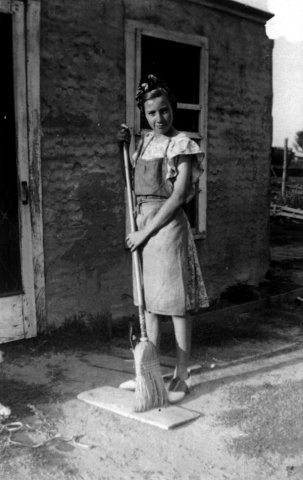Description:
Despite the relative strength of Oklahoma’s economy at the outbreak of the Great Depression, the grim realities of joblessness and homelessness had slowly begun to affect the Sooner state by 1931. By that time oil prices had dropped and president Herbert Hoover seemed powerless to improve the nation’s suffering. In Oklahoma City, hundreds of families began to congregate in the river bottoms along the North Canadian River, most sleeping in cars or flimsy shacks without running water or sewage facilities.
Squatters along the river bank were nothing new to the area, especially since Oklahoma City was well known up down the rails and highways as a place where a drifter would be fairly treated. But the Depression brought many families with children to the camps after jobs and homes had been lost. Health officials feared outbreaks of typhoid and tuberculosis and other diseases if conditions were not improved. Likewise social workers were concerned about the education and well-being of children in these camps.
By late 1931, a new city administration in Oklahoma City had been elected and new city manager Albert McRill decided one of his first major acts would be to relieve the suffering of these families along the river. McRill coordinated the efforts of the Salvation Army, health officals, engineers and the Community Fund, a private group of citizens organized to provide relief to Depression victims. A census of the area was taken and 576 families totaling 2,330 people including 1,085 children were found in need of immediate relief. McRill then used city funds to purchase a tract of land east of South Pennsylvania Avenue and north of the bend in the river there. Streets were laid out and water wells dug. The city also constructed cheap one and two story shacks for residents and a clinic and school were also provided (Lowell School). Soon a Nazarene Church (at that time known for their urban mission work) was established as well. In mid-December, 1931 the camp was ready and city trucks moved the sparse belongings of the squatters to the camp. Inititially known as Irby’s camp, it soon became known as Community Camp. The city did not stop at simply providing housing for the poor. A number of ‘made-work’ jobs were initiated and men were hired from the camp to dig utility lines, landscape parks and build roads among other civic projects.
Community Camp soon became a model program for the country. Several charity and municipal leaders from around the country visited the camp and similar programs would be initiated in over 20 cities. Oklahoma City showed the world what local government working with private organizations could do to help its citizens. The Oklahoma City model is widely credited with providing the model for Franklin Roosevelt’s (elected in 1932) federal relief program. Ironically, it would be the federal program that would cause the decline of quality of life in Community Camp as in 1933 the federal government took over management of the camp. No longer fostered and cared for by its local benefactors, the camp fell into disrepair and the clinic would soon shut down.
Community Camp would survive the Depression though, and it eventually became a place where even the poorest resident could afford rent on a minimal home – often one or two dollars a month. Although conditions in the camp made it the poorest area in the city, most residents chose to live in the area and many former residents look back fondly on the comraderie and sense of community and pride of place present there.
In 1955, the city condemned most of the camp to make way for a flood control project which required widening the river. Displaced residents were paid $400 to $500 for their shacks and given the opportunity to buy lots in nearby Mulligan Flats and other neighboring areas. Lowell School was also closed around this time and most of the children were transferred to Franklin School. The few remaining streets of Community Camp hung on until the late 1970s when the city condemned the area and in 2002 the last of the land was excavated for construction of the MAPS Canal and related river projects.
FURTHER READING
“200 City Families Start Evacuation of Community Camp,” Daily Oklahoman, February 13, 1955.
“300 Families of Squatters Found,” Daily Oklahoman, December 3, 1931.
“City Seeks Camp Site For 576 River Bottom Families,” Daily Oklahoman, December 8, 1931.
“City Selects Campsites to Shelter Poor,” Daily Oklahoman, December 16, 1931.
McRill, Albert. And Satan Came Also: An Inside Story of a City’s Social and Political History. Oklahoma City: Britton Publishing, 1955.
